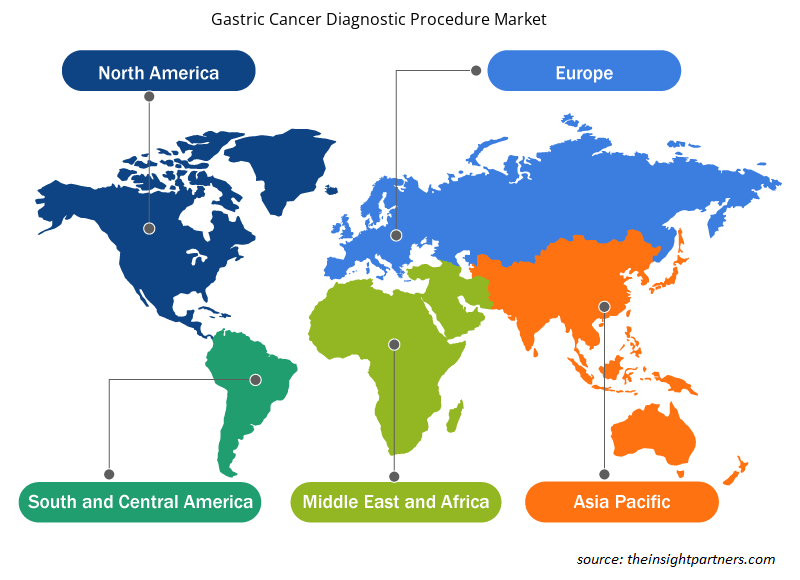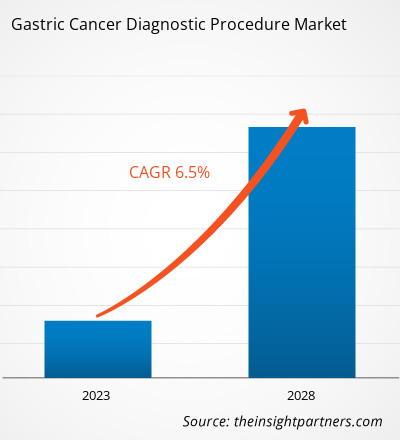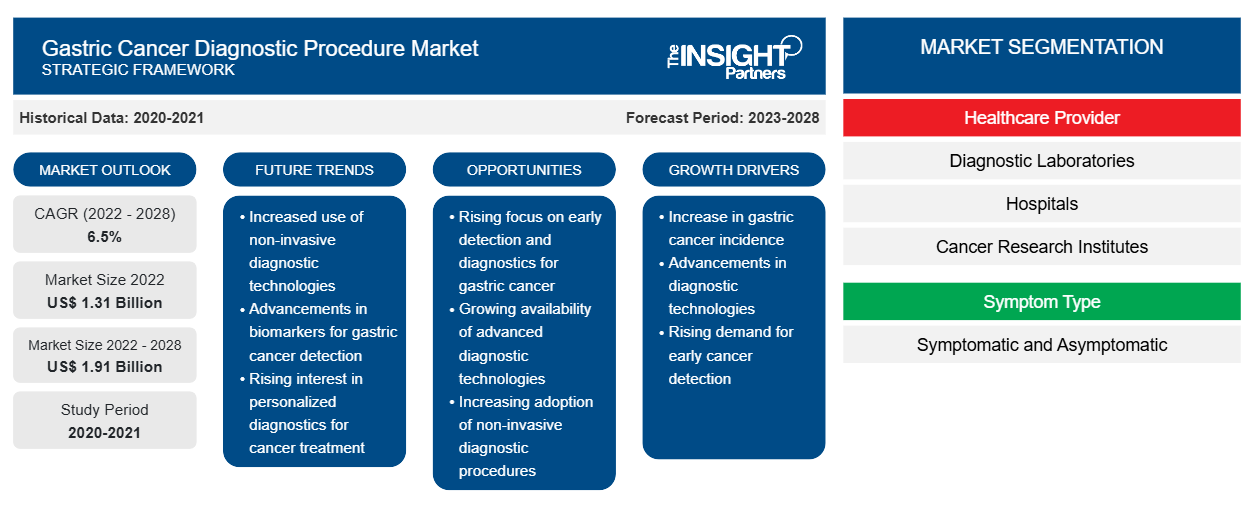Le marché des procédures de diagnostic du cancer gastrique devrait passer de 1 307,96 millions USD en 2022 à 1 912,03 millions USD d'ici 2028 ; il devrait enregistrer un TCAC de 6,5 % de 2022 à 2028.CAGR of 6.5% from 2022 to 2028.
Le marché des procédures de diagnostic du cancer gastrique est segmenté en fonction du prestataire de soins de santé, du type de symptôme, du liquide corporel, de la procédure, de l’offre, de l’indication de la maladie et de la géographie. Le rapport offre des informations et une analyse approfondie du marché, en mettant l’accent sur des paramètres tels que la dynamique, les tendances et les opportunités du marché des procédures de diagnostic du cancer gastrique et l’analyse du paysage concurrentiel des principaux acteurs du marché dans diverses régions. Il comprend également l’analyse de l’impact de la pandémie de COVID-19 sur le marché dans ces régions.
Personnalisez ce rapport en fonction de vos besoins
Vous bénéficierez d'une personnalisation gratuite de n'importe quel rapport, y compris de certaines parties de ce rapport, d'une analyse au niveau des pays, d'un pack de données Excel, ainsi que de superbes offres et réductions pour les start-ups et les universités.
-
Obtenez les principales tendances clés du marché de ce rapport.Cet échantillon GRATUIT comprendra une analyse de données, allant des tendances du marché aux estimations et prévisions.
Informations sur le marché
Augmentation de la prévalence des maladies gastro-intestinales
Malgré une incidence et une mortalité en baisse au cours des dernières décennies, le cancer de l'estomac est perçu comme l'un des principaux problèmes de santé dans le monde. Selon GLOBOCAN, le cancer de l'estomac a causé environ 800 000 décès (soit 7,7 % de tous les décès liés au cancer) en 2020. La maladie se classe au quatrième rang des causes de décès par cancer chez les deux sexes réunis. Environ 1,1 million de nouveaux cas de cancer de l'estomac ont été diagnostiqués en 2020, ce qui représente 5,6 % de tous les cas de cancer. L'Asie représente environ 75 % des nouveaux cas de cancer de l'estomac et des décès signalés dans le monde. Les pays occidentaux, comme les États-Unis et le Canada, signalent des taux d'incidence élevés de maladies gastro-intestinales, qui peuvent être attribués à l'obésité croissante de la population adulte et à une moindre consommation de fibres alimentaires. Selon les données publiées par les Centers for Disease Control and Prevention en décembre 2022, les cabinets médicaux aux États-Unis enregistrent environ 37,2 millions de cas de maladies du système digestif.
La prévalence du syndrome du côlon irritable (SCI) a augmenté dans le monde entier au cours des dernières décennies. Selon l'International Foundation for Gastrointestinal Disorders, Inc., le SCI est le trouble gastro-intestinal fonctionnel le plus courant, avec un taux de prévalence mondial de 10 à 15 %. De plus, les médecins aux États-Unis enregistrent environ 2,4 à 3,5 millions de consultations de patients atteints du SCI chaque année. Bien que le taux d'incidence global du cancer gastrique ait diminué au fil des ans, il a augmenté chez les jeunes adultes au cours des dernières décennies. Ainsi, la prévalence croissante des maladies gastro-intestinales (GI) entraîne un risque élevé de développer un cancer gastrique, ce qui stimule la croissance du marché des procédures de diagnostic du cancer gastrique.
Informations basées sur les prestataires de soins de santé
Le marché mondial des procédures de diagnostic du cancer gastrique, basé sur les prestataires de soins de santé, est segmenté en laboratoires de diagnostic, hôpitaux, instituts de recherche sur le cancer, cliniques spécialisées en oncologie et autres. En 2022, le segment des hôpitaux détenait la plus grande part du marché. Le marché du segment des instituts de recherche sur le cancer devrait croître au TCAC le plus élevé au cours de la période de prévision.
Informations basées sur les types de symptômes
Le marché des procédures de diagnostic du cancer gastrique, par type de symptôme, est divisé en symptomatique et asymptomatique. En 2022, le segment asymptomatique détenait une part de marché plus importante. Cependant, le segment symptomatique devrait enregistrer un TCAC plus élevé au cours de la période de prévision.
Informations basées sur les fluides corporels
Sur la base des fluides corporels, le marché des procédures de diagnostic du cancer gastrique est segmenté en sang, urine, salive, lavage gastrique/suc gastrique, tissus et autres. En 2022, le segment du sang détenait la plus grande part de marché. Cependant, le marché du segment des tissus devrait connaître le TCAC le plus rapide au cours de la période de prévision.
Informations basées sur les procédures
En fonction des procédures, le marché des procédures de diagnostic du cancer gastrique est segmenté en procédures endoscopiques, tests de biopsie et de tissus, tests de laboratoire, tests de diagnostic in vitro, tests d'imagerie, diagnostics moléculaires , diagnostics moléculaires multiplexés et immuno-essais, et autres. En 2022, le segment des tests d'imagerie détenait la plus grande part de marché. Le marché du segment des tests de biopsie et de tissus devrait enregistrer un TCAC plus élevé au cours de la période de prévision.
Informations basées sur les offres
Le marché des procédures de diagnostic du cancer gastrique, en fonction des offres, est segmenté en instruments, réactifs et consommables et services. En 2022, le segment des réactifs et consommables détenait la plus grande part du marché. Le marché du segment des services devrait enregistrer un TCAC plus élevé au cours de la période de prévision.
Informations basées sur les indications de maladies
En fonction de l'indication de la maladie, le marché des procédures de diagnostic du cancer gastrique est segmenté en cancer gastrique précoce et cancer gastrique avancé. En 2022, le segment du cancer gastrique avancé détenait une part de marché plus importante. Le marché du même segment devrait croître à un TCAC plus élevé au cours de la période de prévision.
Informations sur la COVID-19
Des mesures préventives telles que l'élargissement délibéré de l'espace physique pour éviter les contacts étroits et la propagation de la maladie, et l'obligation de porter des masques sur les lieux de travail ont été mises en œuvre dans plusieurs pays pour réduire la propagation du SRAS-CoV-2. Cependant, diverses restrictions ont entraîné l'annulation ou le report des rendez-vous pour le diagnostic et le traitement du cancer gastrique. Selon une étude publiée en 2021 dans PubMed, beaucoup moins de patients ont été diagnostiqués avec des cancers gastriques et colorectaux de stade I pendant la phase COVID-19. Après le premier trimestre de 2020, la demande de diagnostics du cancer gastrique a augmenté dans les institutions gouvernementales et privées pour tester les patients COVID-19 pour une infection à H. pylori. En outre, les patients atteints de cancer gastrique à un stade avancé ont été prioritaires pour le diagnostic et le traitement, ce qui a conduit à la croissance du marché des procédures de diagnostic du cancer gastrique au milieu de la crise du COVID-19.
Informations régionales sur le marché des procédures de diagnostic du cancer gastrique
Les tendances et facteurs régionaux influençant le marché des procédures de diagnostic du cancer gastrique tout au long de la période de prévision ont été expliqués en détail par les analystes d’Insight Partners. Cette section traite également des segments et de la géographie du marché des procédures de diagnostic du cancer gastrique en Amérique du Nord, en Europe, en Asie-Pacifique, au Moyen-Orient et en Afrique, ainsi qu’en Amérique du Sud et en Amérique centrale.

- Obtenez les données régionales spécifiques au marché des procédures de diagnostic du cancer gastrique
Portée du rapport sur le marché des procédures de diagnostic du cancer gastrique
| Attribut de rapport | Détails |
|---|---|
| Taille du marché en 2022 | 1,31 milliard de dollars américains |
| Taille du marché d'ici 2028 | 1,91 milliard de dollars américains |
| Taux de croissance annuel composé mondial (2022-2028) | 6,5% |
| Données historiques | 2020-2021 |
| Période de prévision | 2023-2028 |
| Segments couverts |
Par le prestataire de soins de santé
|
| Régions et pays couverts |
Amérique du Nord
|
| Leaders du marché et profils d'entreprises clés |
|
Densité des acteurs du marché des procédures de diagnostic du cancer gastrique : comprendre son impact sur la dynamique commerciale
Le marché des procédures de diagnostic du cancer gastrique connaît une croissance rapide, tirée par la demande croissante des utilisateurs finaux en raison de facteurs tels que l'évolution des préférences des consommateurs, les avancées technologiques et une plus grande sensibilisation aux avantages du produit. À mesure que la demande augmente, les entreprises élargissent leurs offres, innovent pour répondre aux besoins des consommateurs et capitalisent sur les tendances émergentes, ce qui alimente davantage la croissance du marché.
La densité des acteurs du marché fait référence à la répartition des entreprises ou des sociétés opérant sur un marché ou un secteur particulier. Elle indique le nombre de concurrents (acteurs du marché) présents sur un marché donné par rapport à sa taille ou à sa valeur marchande totale.
Les principales entreprises opérant sur le marché des procédures de diagnostic du cancer gastrique sont :
- Atlas-Link Biotech Co., Ltd.
- Laboratoires Bio-Rad Inc.
- MiRXES Pte Ltd
- Agilent Technologies Inc
- F. Hoffmann-La Roche SARL
Avis de non-responsabilité : les sociétés répertoriées ci-dessus ne sont pas classées dans un ordre particulier.

- Obtenez un aperçu des principaux acteurs du marché des procédures de diagnostic du cancer gastrique
Les acteurs du marché des procédures de diagnostic du cancer gastrique adoptent des stratégies organiques telles que le lancement et l'expansion de produits pour étendre leur empreinte et leur portefeuille de produits dans le monde entier et répondre à la demande croissante. Les partenariats et les collaborations font partie des stratégies de croissance inorganiques observées sur le marché. Ces stratégies de croissance permettent aux acteurs du marché d'étendre leurs activités et d'améliorer leur présence géographique. De plus, les acquisitions, les partenariats et d'autres stratégies de croissance aident les entreprises à renforcer leur clientèle et à accroître leur portefeuille de produits.
- En février 2023, CARsgen Therapeutics a annoncé un accord de collaboration avec F. Hoffmann-La Roche (Roche) pour évaluer AB011 et l'atezolizumab dans le traitement du cancer gastrique. Cette collaboration permettra d'évaluer le médicament expérimental AB011 de CARsgen, l'atezolizumab, un inhibiteur du point de contrôle PD-L1 de Roche, et la combinaison de chimiothérapie standard chez les patients atteints d'un carcinome gastrique ou de la jonction gastro-œsophagienne.
- En janvier 2023, Agilent Technologies a annoncé un partenariat avec Akoya Biosciences pour développer des tests multiplex chromogènes et immunofluorescents qui incluent une analyse spatiale pour les sociétés biopharmaceutiques engagées dans le développement de thérapies de précision contre le cancer. Ce partenariat permet de créer un écosystème qui aide au développement de nouvelles thérapies de précision contre le cancer et offre un flux de travail rationalisé aux clients de ces deux sociétés sur le marché de la recherche clinique.
- En août 2022, MiRXES a lancé une série de nouvelles capacités, notamment une usine de fabrication Industrie 4.0, deux nouveaux laboratoires et un projet de recherche collaborative sur le dépistage de plusieurs cancers. Ces nouveaux développements s'inscrivent dans l'objectif de MiRXES de faire progresser ses capacités de recherche et de production pour développer des tests de détection de maladies basés sur les miRNA.
- En juillet 2022, MiRXES Pte Ltd a lancé le premier projet de recherche clinique à grande échelle au monde : CADENCE (CAncer Detected Early caN be CurEd). Le projet CADENCE vise à développer un test de détection précoce multi-cancers pour jusqu'à neuf cancers à forte incidence et à forte mortalité : cancers du poumon, du sein, colorectal, du foie, de l'estomac (gastrique), de l'œsophage, de l'ovaire, du pancréas et de la prostate.
Marché des procédures de diagnostic du cancer gastrique – Profils d'entreprises
- Atlas-Link Biotech Co., Ltd.
- Laboratoires Bio-Rad Inc.
- MiRXES Pte Ltd
- Agilent Technologies Inc
- F. Hoffmann-La Roche SARL
- bioMérieux SA
- Thermo Fisher Scientific Inc
- Illumina Inc
- Vela Diagnostics Holding Pte Ltd
- Myraid Génétique Inc.
- Analyse historique (2 ans), année de base, prévision (7 ans) avec TCAC
- Analyse PEST et SWOT
- Taille du marché Valeur / Volume - Mondial, Régional, Pays
- Industrie et paysage concurrentiel
- Ensemble de données Excel
Rapports récents
Rapports connexes
Témoignages
Raison d'acheter
- Prise de décision éclairée
- Compréhension de la dynamique du marché
- Analyse concurrentielle
- Connaissances clients
- Prévisions de marché
- Atténuation des risques
- Planification stratégique
- Justification des investissements
- Identification des marchés émergents
- Amélioration des stratégies marketing
- Amélioration de l'efficacité opérationnelle
- Alignement sur les tendances réglementaires























 Obtenez un échantillon gratuit pour - Marché des procédures de diagnostic du cancer gastrique
Obtenez un échantillon gratuit pour - Marché des procédures de diagnostic du cancer gastrique